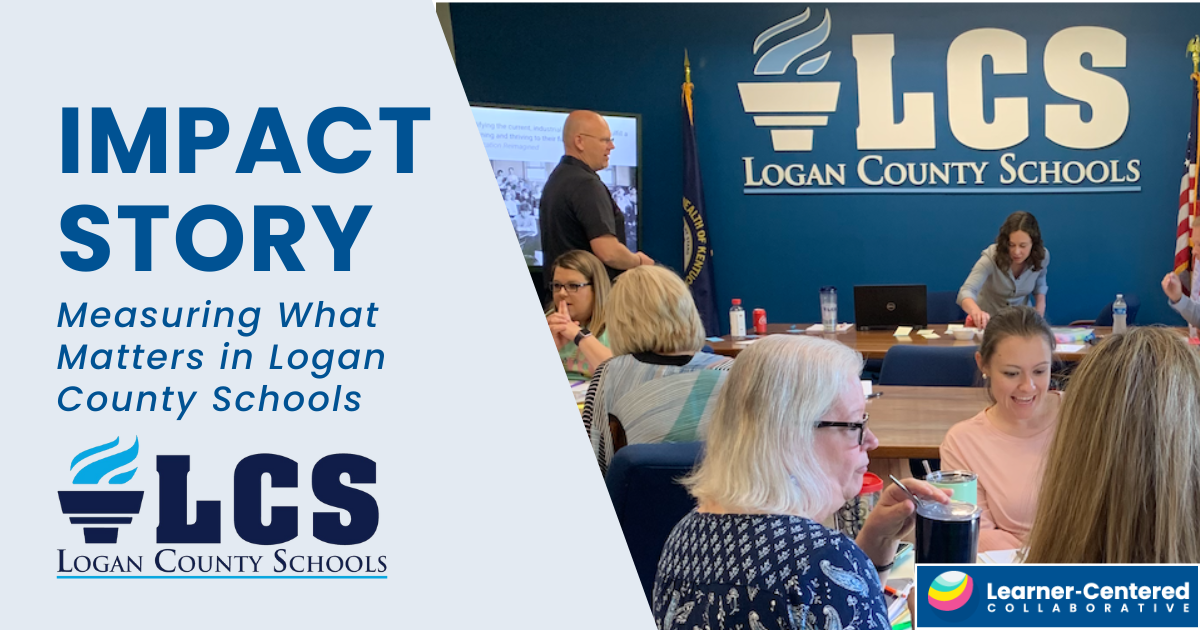Measuring What Matters: Our Journey with Logan County Schools
Contributions from Katie Martin, Learner-Centered Collaborative

At Learner-Centered Collaborative, we believe that meaningful change in education begins with a clear vision and community engagement. Our partnership with Logan County Schools exemplifies this approach, as we’ve work together to redefine success for their students and empower the entire learning community.
Serving over 3,400 students across five PK-8 schools, one high school, and one Career and Technology Center in rural Kentucky, Logan County approached us in 2019 with a challenge: their newly launched Profile of a Graduate lacked community buy-in. Together, we set out to transform their approach to education and create a shared vision of success that resonated throughout the district.
Creating a Learner-Centered Foundation
Our collaboration with Logan County began by laying a strong foundation for learner-centered education. We worked closely with the district to form the LC Innovators, a guiding coalition of educators, administrators, and support staff passionate about learner-centered education. This team collaboratively revised the Profile of Graduate into a Profile of Success, ensuring it reflected the community’s aspirations for its students.
“We aren’t just creating students. We are creating better citizens”
– Logan County Schools Leadership
The LC Innovators didn’t stop there. They developed grade-band progressions to illustrate what success looks like at different stages of a student’s journey, making the profile tangible and actionable for educators across the district.
Building Community Ownership
Key to the success of this initiative has been empowering the LC Innovators to become change agents within their schools. Each team member took ownership of sharing the vision and gathering input from their school communities.
The district also engaged broader stakeholders, including alumni and industry partners, to ensure the Profile of Success aligned with the community’s goals. This approach has fostered a sense of shared ownership and purpose that extends far beyond the initial group of innovators.
From Profile to Practice
With a strong foundation in place, Logan County turned its attention to bringing the Profile of Success to life in classrooms. We implemented Learning Walks, allowing educators to observe and share best practices across schools.
The district also developed Success Indicators and a Learning Model, providing a framework for both student and educator competencies. This alignment ensures that everyone in the district continues to work towards the same goals.
A significant milestone was the introduction of Defenses of Learning for grades 5, 8, and 12. These presentations allow students to demonstrate their growth and achievement in relation to the Profile of Success.
Measuring What Matters
Our partnership with Logan County has led to a fundamental shift in how they approach assessment. Moving beyond traditional testing, they’ve embraced performance-based assessment through Defenses of Learning, exhibitions, and showcases.
This new approach has broadened the definition of success, culminating in the development of Pillars of Success. These pillars provide a holistic view of student achievement, encompassing academic, personal, and community-oriented growth. To ensure ongoing progress and transparency, Logan County Schools created a dedicated page detailing success metrics for each pillar. This platform serves as a dynamic tool for the district, allowing them to continually revisit and refine these metrics. Importantly, it also functions as a communication hub, enabling the district to regularly share updates, achievements, and areas for growth with the broader community. This commitment to clear definition, continuous improvement, and open communication has been instrumental in maintaining momentum and fostering sustained community engagement.
Impact and Results
The results of this transformation have been remarkable:
- 100% of students in grades 5, 8, and 12 participated in Defenses of Learning in the 2021-22 school year.
- Students have demonstrated increased ownership and engagement in their learning.
- Learner-centered practices have spread beyond the initial LC Innovators group, becoming embedded in the district’s culture.
Learner-Centered Practices in Action
The power of this work is best illustrated through individual stories. During a recent visit in March of 2024, Katie Martin from Learner-Centered Collaborative observed high school student Cole’s Defense of Learning. Cole confidently presented his goals and aspirations to a panel of community members and teachers.
What struck Katie most was the enthusiasm of Cole’s teacher – someone who hadn’t been directly involved in the initial LC Innovators group. This moment demonstrated how deeply the learner-centered approach has permeated the district, with educators taking ownership and pride in the process. Katie, who worked closely on this partnership, saw firsthand how the initiative had spread beyond its original champions to impact the broader school community.
Looking Ahead
Logan County Schools continues to refine and expand its learner-centered practices, always with a vision toward improving outcomes for students.
Logan County’s journey offers valuable insights for other districts considering a similar shift:
- Community ownership is crucial. By involving stakeholders at all levels, Logan County created a shared vision that resonates throughout the community.
- Measuring what truly matters in student success requires rethinking traditional assessment methods. Logan County’s shift to performance-based assessment provides a model for holistic evaluation of student growth.
- Change is possible in any district. With the right support and a commitment to learner-centered principles, districts can create lasting change that benefits all students.
Our partnership with Logan County Schools demonstrates the power of a clear vision, community engagement, and a focus on what truly matters in education. Their journey serves as an inspiration and a roadmap for other districts looking to evolve their approach to student success.
Connect with us today to explore how we can support your learner-centered journey.






